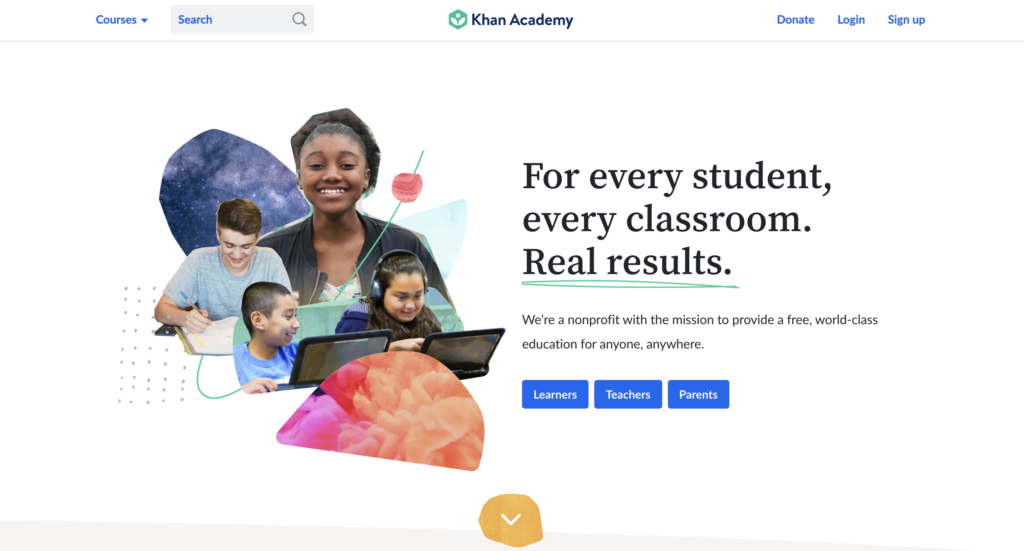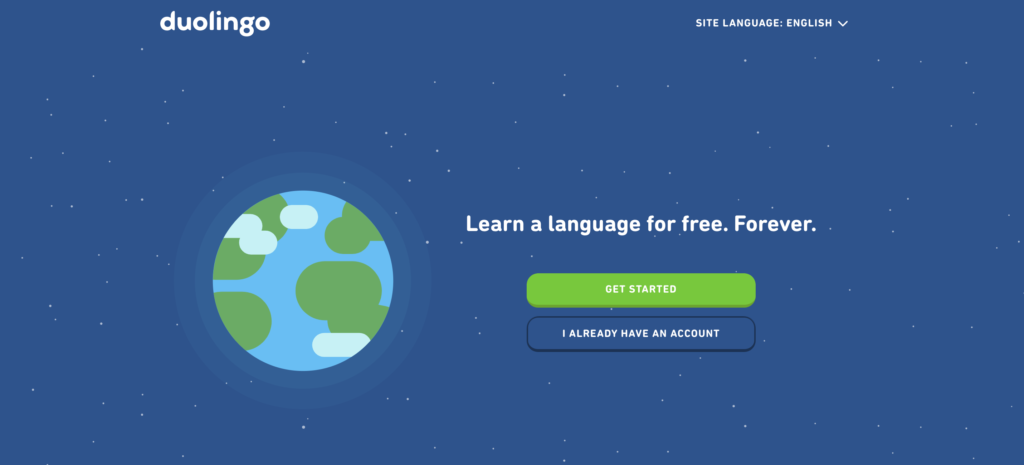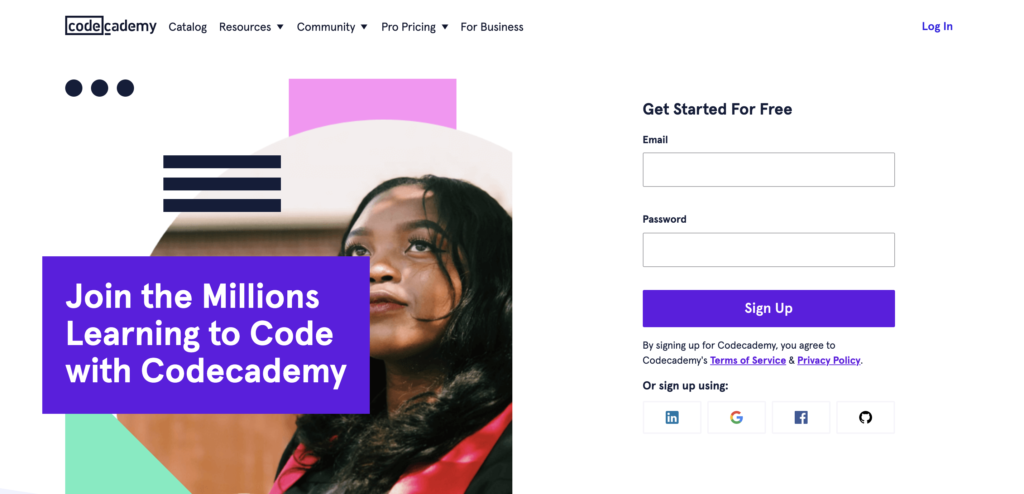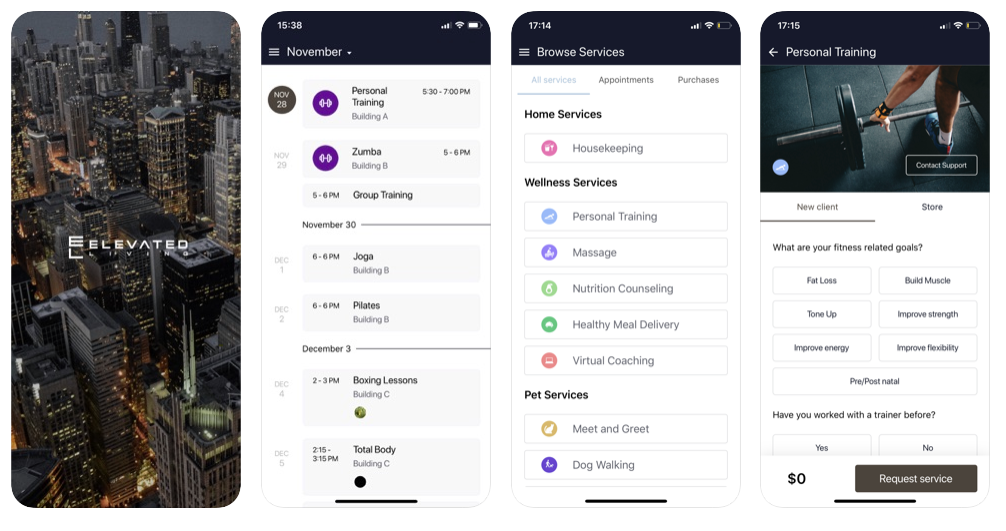The backend (in other words the server-side) of an application or a website is something invisible to the eye of the user. It’s a tech layer responsible for storing and organizing data that controls all functionalities and ensures everything on the client-side works without errors. The backend also communicates with the frontend (the layer visible to users) sending and receiving information to be displayed as a web page.
The server-side can be built using many different technologies that will provide the necessary performance and security of the product. The important part is to choose a backend technology that will correspond well with the chosen frontend. In our case that would be React.js, one of the most popular JavaScript-based technologies.
The Javascript library was originally developed and used by Facebook developers until in 2013 the tech giant decided to make it open-source. Soon it was used by the biggest companies worldwide like Google, Facebook, or Netflix. React.js revolutionized the way developers build apps and allows them to create remarkable UI components. You can read more about why we base our work on React.js here.
React.js is a part of the tech stack in multiple projects of different sizes. Let’s see what backend technologies are usually chosen by developers having React.js as frontend technology.
React Native was released in 2015 and is a JavaScript framework – a platform for native mobile application development. As the name suggests, it’s related to React.js as it was actually based on it. The combination of these two technologies gives an application a boost in the form of great performance but also a great user experience for mobile device users.

React Native offers a range of innovative features such as hot reloading of which you can read here.
PHP, Java, Python – these three are solid backend technologies we all know about. But what about JavaScript? It’s a programming language known as full-stack technology. JavaScript may be used for developing both – the frontend and the backend of an application. Sounds good right?
Node.js is a server-side runtime environment based on JavaScript. Which means it’s not a programming language nor a framework. It’s an environment that’s built on a JavaScript V8 engine that adapts JS functionality and syntax to backend development. Combining React.js with Node.js allows developers to build applications that are isomorphic; the communication between the client-side and server-side of the application is fast and efficient.
Find out which famous apps were built with Node.js
React can be often seen paired with Django – a high-level Python-based framework for backend development that is also open-source. The main advantage of Django is scalability – it can be used for building both simple projects and complex solutions capable of handling heavy traffic and large volumes of data.
There are voices that say the two have nothing in common, however, both technologies are used by Instagram. What’s more, many developers state that if a web framework can respond to HTTP requests with JSON and HTML, it can be used with anything.
There are enough reliable backend technologies available for you to choose one for your React application. Choosing the right backend and frontend technology will help you save your resources and work more efficiently. As there are so many options, you should carefully consider your needs and expectations regarding your product.
Our Redvike team will be happy to advise you on the appropriate tech stack for your application. Contact us to learn more about what we can do for your business.
EdTech developers provide solutions that offer tremendous opportunities for the education industry. Using today’s technology they are able to create an immersive learning experience in a compact form of an application. Some of the products are amazing in helping people to expand or improve their skills. They can track students’ performance and motivate them to be better in their field. Part of the success is a product strategy and great UX design but what’s taking the lead in educational apps is, of course, technology.
Without the good back-end and front-end technology, an app wouldn’t be able to provide the users with expected performance. Without all the modern tricks such as gamification or voice recognition, it just wouldn’t be an app from this age. That’s why it’s important to choose the right technology for your EdTech solution. At the heart of Redvike lays all of the React family. That’s why today we’re going to focus on some of the best educational apps built with the use of the JavaScript library – React.js.
It’s not just about school education. There is a clear trend towards learning through educational content shared on the most popular social channels. A good example is what’s happening on TikTok – the fastest growing social media app for creating, sharing, and discovering short videos. In May 2020 TikTok has announced its plans to encourage its community to self-educate by launching a new #LearnOnTikTok platform. The plans include collaboration with experts from various institutions who will be responsible for creating educational content.
With the Internet availability, the increase in smartphone use, and the growing popularity of social media, eLearning has the best conditions to finally be recognized and developed on a big scale. However, if we want to deliver useful content that inspires, and drives engagement, we should base our product on modern and reliable technology.
It turns out that behind some of the best eLearning platforms there is a well-chosen tech stack – including React.js, that holds it all together. Here are five great educational apps we’ve picked that use the power of the JavaScript library.

It’s an American, non-profit EdTech organization established in 2006 by Sal Khan that produces educational content for students and educators. Their online platform is filled with short videos, supplementary materials, and useful tools to enhance the learning experience.
Khan Academy underwent a major upgrade to React.js which provided the platform with smooth element changing and the elimination of unnecessary re-renders. What’s more, in July of 2020 the platform finished a complete migration to React Native. The reason for that was the challenges of maintaining two codebases with a small mobile team. By making a switch from Backbone to React technology the organization is able to introduce changes to their app in a more efficient way, eliminating the number of errors and cutting the time of development.

Skillshare is an online learning community sharing thousands of inspiring classes on topics including illustration, design, photography, video, freelancing, and more. The company was
founded in 2010 and has its HQ in New York. This type of on-demand learning has recently gained a lot of recognition in the US thanks to the personalized approach and the spectrum of available classes.
Skillshare offers incredibly engaging content that attracts the right audience. The EdTech platform was built with the use of React.js which supports the smooth interaction of UI elements and the creation of a user interface that enhances learning.

Sana Labs is a global leader in the development and application of AI to learning. One of their core products helps users improve pronunciation when learning a new language. Their all-in-one learning platform has a built-in AI mechanism and analytics that tracks the user’s performance – it was developed in a collaboration with our Redvike team.
We built a responsive React.js app using Sana’s eLearning API, to provide the company with a showcase of their technology and highlight the power of their solution. The React.js product has become a vital sales and marketing tool for Sana. The company also won a CogX award for the Best AI Product in Education.

Who doesn’t know Duolingo? Duolingo operates as an augmented reality app embedded with a multilingual chatbot, to improve speech recognition capabilities. The language learning app appeared in the market in 2011 and in just two years earned the title of iPhone App of the Year. Certainly, it’s one of the most popular educational apps and also the one built with the use of React.js.
The frontend of Duolingo was written in Backbone.js and Mustache but is now primarily in React and Redux. The use of Javascript library enable the app to capture the attention of users with its highly responsive UI components, transitions and navigation that guarantee remarkable user experience.

Lastly, an American educational app offering free coding classes in 12 different programming languages including Python, Javascript and Java. As a web app designed specifically for developers wanting to learn or improve their coding skills is a great position in the Edtech app category.
In August 2014, Codecademy decided to fully incorporate Facebook’s library, and till this day React.js is one of the key scripts included in the app. The company’s team admits that there are a few things they appreaciate the most in React.js. They include the battle-tested script, compatibility with legacy code, flexibility and the way it cooperates with SEO.

React.js is widely applied in the EdTech industry. It supports the user experience in most advanced and popular educational apps in the market. Its features were recognized by global leaders and innovators not only in the field of eLearning but also by pioneers in AI technology.
One of the reasons is for sure the performance it provides. Above all, it’s reliable and supported by a tech giant – Facebook, technology that when incorporated into your digital product, saves a lot of in-house resources while attracting more users to your app.
React technology is literally the heart of our company. Since the beginning, we’ve been creating web and mobile applications this way as we value scalable and modern solutions. Knowing the framework inside out today we share some good resources to learn React Native. Enjoy!
React Native breaks records. The JavaScript framework has not only gained recognition among all developers by being on the top of the favorite cross-platform technologies but also more and more often takes a significant place in the tech stack of global brands. Thanks to its innovative features, it’s superior in comparison to competitive technologies and its rapid development ensures high demand for specialists in the market.
If you ask a developer how to learn something there are high chances you get a response “read the documentation”. We recommend that too as the best way to understand how something works is to study its functionality and logic behind it. Fortunately, React Native has its documentation written in a simple and accessible language.
You can find it here: https://reactnative.dev/docs/getting-started
The most obvious point on the list are all kinds of online workshops where you can learn coding following a crash course. There are plenty of courses on Udemy offering React-based lessons. Among all the availble tutorials we picked up a few that we think are useful:
The Complete React Native and Hooks Course. Here it’s a 2020 edition but sooner or later there will be a new one for the upcoming year. This course will help you understand the fundamentals of React, the terminology, concepts of Redux but also it will teach you how to quickly build a prototype and deploy your own applications to the Apple and Google Play Stores.
Build Full-stack React Native Apps with Express.js Backend. This one is more practical as at the end of this course you will know how to build 4 apps using Redux, React Navigation, MongoDB, Node/Express. The workshop is more on a medium level so it’s not the best choice for beginners but on the orher hand, if you learn better through practice, go ahead!
React Native: Advanced Concepts. When you finish the two previous courses, you can start with something more advanced. In this course you will learn how to build React Native apps with Expo, create eye-catching animations, use expert-level features of the framework, use React navigation to the full, add logic to your Firebase backend with Google Cloud Functions, engage users with Push Notificatiosn and use Redux Persist.
When it comes to literature, a good complement to online courses will be a book called FullStack: React Native. It’s a complete guide to React Native that covers everything from components to the deployment. For sure it will give a meaning to all the stuff you’ve learned so far during online workshops. Another great reading is Pete Hunt’s tutorial about ReactJS – Thinking in React. It’s more for the better understanding of React logic and the components machinery.
Don’t forget to check our blog where we often publish useful content about React and React Native. Here are some of the posts you may find useful:
What’s new in React 16.6 and 16.7
Regardless of whether you are a React geek or a beginner, the resources will help you get through the basics of the framework and end the journey with some solid practical experience. We hope you will get use of our knowledge base as well 🙂 Good luck!
You can also read:
What is React Native used for?
Top 5 companies using React Native
The success of the learning app Duolingo has motivated many entrepreneurs to try to build its replica. The startup located in Pittsburgh built an app that in 2019 was valued at $1.5 billion! If they made it, why not follow the trace and create something even bigger? Today, we’re diving into the company’s success to show you how to build another Duolingo!
Duolingo is one of the most popular free educational apps. But it has earned its title. To this day the company expands and improves the UX and UI of the learning platform. Recently they designed and added brand new characters to their project world! The amount of work put into this product had to pay off one day. Now let’s decode the awesome features of the app and some must-have elements.
There are some functionalities that a language learning app should offer:
The main use of the app is to learn people. Practice makes perfect so if you want to build the best language learning app – make sure it offers a wide range of training exercises: learning new words, reading and translating text, listening comprehension, and so on.
According to Duolingo co-founder – Luis von Ahn, chatbots make the learning process less embarrassing. It’s a useful mechanism worth implementing into your learning app. Chatbots can answer basic user questions i.e. if the pronunciation of a given word is correct. They can also provide the user with assistance in a form of speech translation.
Another great idea! Duolingo has a library of stories written in different languages that help users be better in building more complex sentences. Giving users access to their favorite books written in different languages would be so cool! Especially if reading would be accompanied by useful hints and tips. For example, users would tap the difficult word to see the translation or would tap it twice to hear the correct pronunciation of it. Articles are also an option! A bit shorter form that can encourage more users.
What’s the best way to learn a foreign language? Watching series and movies in that language! Implement video content into your app to make the lessons more appealing to a user. Connect learning with relaxation offering content in a form of music videos and fragments of movies. Of course with the subtitles option 🙂
We’ve talked about the interactive ways in which you can provide language lessons to users. Now let’s talk about the way you will build your app.
Follow the good practices to build a learning app people will love!

Great apps come with great technology!
If you’re a beginner and want to set up your app without investing some major costs – use cloud services. Backend costs can be pretty overwhelming but luckily there are other solutions you can use. Build your Duolingo on Firebase! Here’s an article explaining why choosing Firebase is the best option (of course the more complex your product will get, the more advanced solution you’ll need).
When it comes to building a learning app for multiple platforms we strongly suggest you get familiar with cross-platform development and to be specific – React technology. The apps built in React have the look and feel of a native mobile app, which makes the user experience on a superior level! To know more read about 5 advantages of React js. or innovative features of react native development.
When it comes to implementing voice recognition or text-to-speech features – don’t worry we got your back! At Redvike we’ve already built projects based on that technology so we can guide you and answer all your questions. Leave us a message and we’ll reach out to you!
At Redvike we build superior apps every day
Build your app investing in a non-breakable backend technology, excellent design, and remarkable user experience. Be the visioner while having an experienced team of React developers at your service.
Let’s build something great together!
As a React js development company with years of experience in delivering React-based applications, we know this technology inside out. And not only we know it, but we love it. Today we would like to share with you reasons behind our choice to create software projects this way. Here come the 5 advantages of React JS.
React has already become mainstream as it is widely used by the biggest companies worldwide – Google, Facebook, Netflix – to name a few. The JavaScript library revolutionized the way developers build apps and certainly, it’s a go-to if you want to create products in a more modern style. What does it bring to the table? Have a look at the advantages that lay in the very nature of React technology.
The following 5 advantages of React JS makes it a must-have in the technological stack.
The DOM is short for document object model which is a logical structure (in a tree form) of documents in HTML and XML formats. It is an object-oriented representation of the web page, which can be modified with JavaScript.
If you want to develop an app that has a lot of user interaction you have to carefully consider its tree-structure because the way it is formed impacts the performance. Everything in DOM is connected. Frequent data updates and changes at the top level of a “tree” can eventually affect the user interface and may result in poor user experience.
When we have real DOM, a server processes the changes (queries, user interaction) through an update of all the trees, which is thousands of elements! In React there is a virtual representation of the DOM that increases the speed of data updates without impacting other parts of the interface. Thanks to it, React developers use hot reloading – they can apply changes in real-time, building dynamic UI components. The virtual DOM environment increases productivity and facilitates the whole work on a project.
Another time-saving feature is the ability to reuse code components. We’ve talked about this in the article about PureComponent. Using React, developers can easily manage updates, producing code more efficiently. Building an app they can just reuse what they’ve built already and expand it to a more complex feature. All React components are isolated and change in one doesn’t affect others which makes it super convenient. In essence, code reusability makes it easier to develop and maintain a product as it allows for fast and precise testing procedures.
On the list of advantages of React JS. there is also the toolset dedicated to the development environment. React offers great developer tools to better design and debug products. The tools are in the form of a browser extension (for Chrome and Firefox) that enable developers to scan, examine, and edit the components in the virtual DOM. There are also tools specifically for those who use Redux. Redux, although it’s not a React-only thing, is something every React developer should know about. It simplifies storing and managing components states of large and complex applications. Redux tools allow developers to observe dispatched actions and modify stores.

Explicit data binding in other technologies makes it difficult to apply changes in a way that doesn’t affect the rest of the app structure. Downward data flow in React JS. ensures the changes in child structures (lower levels of tree structure) don’t affect their parents. Developers can modify the state of an object and after, only specific components will be updated. This way they produce stable code which improves app performance.
Finally, the one and only React Native which is the framework for mobile app development. The way it accelerates project delivery process is incredible. React Native is used for building natively rendering mobile apps that can be simultaneously developed for iOS and Android. Also, has a great number of innovative features that ease the work on a product by saving both costs and time. Here you can read more about what is React Native used for.
Lastly, we have to mention the community around the technology that keeps expanding. Having so many people interested in React, the number of useful resources to learn it and develop your skills are endless. If you want to learn more about React JS. you can easily find great tutorials, articles, and people that will support you on the way. Including our React JS development company 🙂
To summarize, React JS. increases productivity, improves user experience, and saves a lot of in-house resources. It’s a perfect example of a technology that lets you eat a cookie and have a cookie. It’s a solution that can significantly optimize efforts of web development and increase its efficiency. And it keeps improving!
React Native earned no 1. place among the most used cross-platform mobile frameworks of 2019 and 2020. According to statistics, 42% of software developers worldwide use React Native as their main framework for mobile app development. And it’s not a surprise as the technology offers a long list of advantages that accelerate the work on a project and ease the life of developers. Here are some of the most innovative features of React Native Development.
Mobile app development is a complex process that requires an investment of time and money. When we base an app on modern, powerful technologies like React Native, not only we can speed up the whole process but also reduce the costs associated with it. The capabilities of React Native Development are very impressive that’s why the technology gained so much popularity over the years. But if the framework is new to you check out our article What is React Native used for?
The reason why this technology is so popular is the range of innovative features it offers.
React Native enables developers to build a codebase that can be reused on both iOS and Android. It means, they don’t have to build a separate app for each platform. Instead, they can use the same code and accelerate product development. Also, if a company has already developed its web app, most of its code can be used to develop a mobile app (if it was built in React). Adding up lots of prebuilt components and open-source library, the whole process goes incredibly fast and code reusability ensures there are fewer inconsistencies between two platforms.
Live updates are another innovative feature introduced by the framework. Native app development requires manual upload of the new version to the App Store or Android Play. Only after the stores approve the changes, the update is available to users and they have to install it on their smartphones. React Native development requires no such actions. An update runs locally either by using JavaScript files embedded in the app or by fetching the latest changes from a server. It means that an update is released immediately.
Native apps work faster and more smoothly but the cost of the development is high if we want to support it for both platforms. React Native enables you to build an app that offers a native-like performance as most of the code applies to iOS and Android. It’s a big saving in time and investment when we can achieve two things at once and stay native. Same things when we want to push updates – we can do it simultaneously on all platforms.
An app built with React Native has much to offer when it comes to user experience and user interface. Thanks to React JavaScript UI, the app is more responsive and has a decreased load time which greatly contributes to the level of user experience. With React Native you can build an app that has simple UI but that’s what makes it powerful and attractive to users.
Since technology is rather young, there are features that are yet to be developed. For this purpose, the framework supports the thrid-party plugins which are the Native Modules and JavaScript Modules. If you build a React Native app and want to integrate it with Google Maps or other Google tools you can do it with the help of plugins and apply all the necessary features in a convenient way.
The technology turned out to be a great choice for many top-shelf companies. Check out what are the top 5 companies using React Native.
The ability to develop a code that is compatible with all platforms can be a game-changer for a business. Cross-platform development increases the productivity of the whole project team thanks to the innovative features. Not to mention how much a company can save just by choosing React Native development.
Code reusability, lots of prebuilt components, and facilitated testing phases. It all makes the product reaches its final stage way sooner and is ready to enter the market. It’s the speed that gives your company an advantage as in such a short period of time, your app is fully prepared to be used by customers (on both platforms!).
Since you can code for two platforms at once, you don’t need to hire a room of react native developers. Depending on the complexity of your project you may need just 2 or 3 specialists in this field. A smaller team means lower costs of development. Also, the whole process takes less time as React Native greatly eases the work of developers. For you, it means less money invested in the project.
The framework is based on well-known and established through years – JavaScript. It won’t be a problem for a business owner to find developers experienced in this programming language. What’s more, React Native is a community-driven technology with an open-source environment. The benefit for your company is that all the data and documentation of the framework are available for everyone.
If you want to create a product that melts the hearts of customers with remarkable user experience, we are ready to deliver it! Only by choosing to base your app on React Native, you gain a huge advantage from the speed of development and the low costs of maintenance. We will guide you through the whole process and show you possible solutions so your product benefits more people. Let’s talk about your idea!
With the ever-rising popularity of React Native, we could notice some great examples of applying the technology into products. Despite being rather recent, it’s been already used by many startups and enterprises of various sizes and from different industry sectors. From all the examples we distinguished a list of top 5 companies using React Native. Do you want to know why they decided on that technology? Keep reading.
From our previous article, you could learn about What is React Native used for. Today we want to find the reason behind the choices of 5 companies that decided to use React Native for their products.
React Native performance was appreciated by Walmart, a company that was once the world’s largest online retailer. Walmart wanted to build a hybrid app. It’s an app that is based on a part of the native code and the part that is built using a cross-platform technology (i.e. React Native). They already had mobile apps but needed to rewrite them for both Android and iOS.
Since React Native enables code reusability, the company’s developers could optimize their work by making changes only for one operating system. With 95% of the codebase being shared between platforms, the company reduced their costs by half and greatly increased the organization. The software developers were able to leverage their experience with web technologies to create mobile features and the overall work was very convenient thanks to instant page reloads, ready-to-use components and Over the Air (OTA) code push to fix critical issues. Deciding to use React Native, Walmart achieved great development performance and could improve customer experience. Up to this day, Walmart’s mobile apps are almost entirely based on React Native.
Another React Native example is Pinterest, a social media platform that’s based on sharing creative content to users. With billions of Pins available on the app, users can always find inspiration in the form of graphics or videos. The content is constantly shared, updated, and added to users’ personal folders. That’s why Pinterest has to work flawlessly and meet performance expectations.
In order to achieve that, the company decided to use React Native technology. The initial implementation on iOS alone took the engineers about 10 days. Next, in two days the team was able to transfer it on Android with 100% UI code being shared between platforms. Using React Native, Pinterest saved hundreds of hours on the development process. Also, code reusability ensured there were fewer inconsistencies between the iOS and Android versions.
Among the top 5 companies using React Native, there is also UberEats. Uber created the app with the aim to facilitate the food delivery process. Also, the app enables people to become a delivery partner of restaurants and earn money through food delivery. What was the challenge in the project was to connect restaurants, drivers, and customers.
The development team had to translate the existing restaurant dashboard from web to mobile version (iOS and Android). The only right move was to do it with the use of React Native magic. Code reusability but also Live Reloading and cost efficiency were saviors in this sort of undertaking. One of Uber’s software engineers mentioned the benefits of the framework’s capacity for expanding the service.
Bloomberg is a media company that provides global business and finance news but also delivers software solutions for enterprises. Their mobile app was to provide the same experience and access to information as if users were using the web version of the platform. What’s more, Bloomberg was spending a lot of time updating both iOS and Android app individually. React Native was a perfect solution to speed up the update cycle and further mobile app development.
The React Native performance enabled the company to not only rebuild their mobile app on both operating systems but also add a lot of new features to the offer such as live TV access or experience personalization. React Native implementation also allowed the development team to achieve the continuous update cycle which highly optimized their workflow.
Discord is a free voice and chat app dedicated to gamers, however, a lot of users use it as a social media platform. The app enables users to chat with the team in real-time while playing games. Discord was one of the first React Native apps introduced to the market as the company decided to implement the technology for its iOS app before React Native’s official release in 2016.
Making Discord a React Native platform enabled the company to take advantage of the reusable code and make quick product iterations with just two persons on board in the development team. Discord iOS and Android applications share 98% of the codebase which is a game-changer in cross-platform development.
The above top 5 companies using React Native generated impressive results and reached performance that helped them greatly expand the business. React Native offers companies a lot of benefits throughout the process of implementation and development. By combining the advantages of native and hybrid apps, the technology speeds up the development process, provide native-like experience and a significant cost reduction.
If you need a React Native solution for your company, contact us!
Software developers appreciate technologies that besides offering high-quality outcomes, are also pleasant to work with. That’s why recently, React Native gained so much popularity in the IT field. The technology certainly has much to offer that’s why today we’re going to focus on – what is React Native used for.
To start this in the right way, first, we need to distinguish two technologies:
React js. is a JavaScript library to build powerful and innovative user interfaces. It is also the heart of the React Native functionality. React js. was developed by Facebook to address the needs of high performing UI components. The technology receives big support from the community that continuously works on its development.
React Native is a JavaScript framework that enables creating native mobile applications for iOS and Android. It offers an open-source environment, great portability, and is easy to work with. Using modern technology contributes to minimizing the overall costs of product development and maintenance.
React Native is used for building natively rendering mobile apps that can be simultaneously developed for iOS and Android. Software developers use the JavaScript framework to accelerate product development. React Native is equipped with pre-developed components and its portability eases the whole process of writing an app. It brings high-speed processing, great responsiveness but most importantly – the best user experience to your product. Using the framework Native, companies can produce high-functioning mobile apps that, in the end, are comfortable to use just like the native ones.
As was mentioned at the beginning, React Native is one of the solutions that provide developers with a lot of conveniences during work.

Companies that offer React Native development services are in a center of interest to most tech leaders. The technology offers numerous advantages making React developers valuable on the market. Working with Redvike you get access to a team of skilled, ambitious, and hard-working React developers who can help power-up your product’s performance.
In need of a React solution? Contact us!
With the upcoming new year, there are a lot of interesting and worth visiting tech conferences and mobile apps events planned. It’s a great opportunity for companies to learn about new technologies, expand their business network and show their product or services to the worldwide audience. Among hundreds of tech events, there are several that we find most valuable and worth your attention.
Let’s start with the largest mobile app event in the world that this year will be held in Barcelona, 24-27 February (also in Los Angeles and Shanghai). It’s not a cheap conference but the experience and acquired knowledge fully compensate for their pricy tickets (from €799 to €4.999). MWC is made for everyone interested in the subject of mobile apps trends and the innovations available in this field. The agenda includes various tours and lecturers as well as exhibitions. The event brings all the top mobile app development companies together so you can’t miss this.
It’s already a 6th edition of the original hackathon dedicated to the React ecosystem. React Europe conference takes place in Paris on May 12 and lasts until May 16 (12-13 & 16 workshops, 14-15 conference). It gathers speakers with unique and futuristic ideas that inspire people working with React Native, React.js, GraphQL and many more. The schedule includes lectures and workshops with Gatsby.js, Relay and of course, React. It’s a must to be there if your company chose this technology as a leading one. The tickets are already available and their prices are €399.00 + €79.80 VAT (for a one-day workshop), €449.00 + €89.80 VAT (for the conference) and €625.00 + €125.00 VAT (for the two-days workshop).
The expected number of developers that will take part in the World Congress 2020 is more than 10 000 people and over 250 speakers. The event takes place in Berlin on May 28-29 and is about to gather all the developers that are interested in JavaScript, React, UX/UI, Data Visualisation and more topics of which you can read here. Among past speakers, there are Steve Wozniak and Håkon Wium Lie. The aim is to inspire, educate and motivate people who love coding by creating the world’s leading community for developers. The Regular Pass price is now €129.00 while Premium Pass costs €379.00.
Join the 9th summit of most innovative CX (customer experience) leaders. It’s the biggest CX event in North America with over 50 speakers, 15 case studies, 4 keynote speeches, 6 track sessions, and 3 interactive panels. The agenda includes a panel with Perry Monaco (from LinkedIn). Also, there is a keynote speech from Tom LeBaron (from Walt Disney Company). Apart from that, there are track sessions for example, about mobile metrics and analysis or case studies providing insight into the obstacles of building trust with online customers. CXS Summit starts on April 16 (and 17), in Westin Harbour Castle in Toronto (Canada). Get the tickets!
Something for JavaScript lovers. The conference takes place in Budapest, Hungary on September 24-25, however, it’s not the only location. JSConf is a non-profit organization that each year arranges a series of worldwide tech conferences. They are held in China, Colombia even Hawaii. All the locations are here. The main topic is JavaScript and all the lectures are conducted by a group of experienced enthusiasts eager to share with their knowledge. What’s great is that they attracted sponsorship and attendees from such companies as Google, Facebook, and Microsoft. The early bird tickets are on sale now and start at €205.
GDC is the game industry’s premier conference that supports the work of game developers and the advancement of their craft. The event runs from March 16 to March 20 in San Francisco. It gathers all people interested in the gaming business. Here you can learn how to create an impressive game app and run a successful game business. Also, get inspired by the achievements of others and participate in various interesting discussion panels. The schedule includes topics such as “Real-time character dynamics” by David Coleman (Microsoft) or “Adapting: Working in games with chronic illness” by Victoria Dorn (Sony Interactive Entertainment).
In 2020 mDevCamp returns with the 9th edition of the largest mobile app concentrated conference in Central Europe. This year’s schedule will cover topics of hacking, AI, augmented and virtual reality, IOS, Android and life hacks for developers. It’s definitely a go-to tech event that you don’t want to miss. Last year we could listen to Sangsoo Nam from Spotify, Andrea Falcon from Google or Mike Grabowski from Callstack. Who will join us on May 29 in Prague? Tickets start from €97 but only until January 16th so hurry up.
APS will come back on April 2 in London to once again talk about the top growth marketing strategies. This one day is filled with short talks and deep discussions as well as many interactive sessions. All are provided by the world’s top app growth experts. The 2020 agenda will cover app growth through influencer marketing, App Store Optimization, user acquisition, analytics, engagement, and retention. Among the attendees, they were already members of Adidas, Revolut, Snapchat or Twitter. The conference takes place also in NYC and Berlin. You can register here.
It is the largest Android-only conference that brings together all Android developers to talk about the newest trends connected to this environment and its development. The conference is divided into several smaller lectures. The main topics are testing, security, smart home solutions, mobile payment solutions, and many other innovations. DroidCon will be held in Berlin July 1-3 and the ticket price is €359 (regular) or €119.00 (student).
The last one is a cherry on top as it takes place also in Poland and even in our home city – Cracow. Although it’s not entirely about mobile apps, the mobile app development topic covers a large part of the agenda at this year’s event. Other areas that will be discussed during lectures are for example Cloud services, Java SE, and the Internet of Things. The conference takes place on June 17-19 and the pass entry costs 999 PLN (€250 + 23% VAT).
In this text, we don’t want to encourage you to walk around the entire conference and visit each booth and generally waste time. When going to conferences, it’s best to review the agenda, see what is most valuable to us, and go only to these events. Workshops are usually the best choice. Just as big presentations are a form of show, the workshops focus on providing specific knowledge to the participants helping them develop. That’s why choose wisely. Another leash or pen is not worth much when instead you can meet people from whom you can learn a lot or with whom you will work in the future.
Apparently, there is still a group of entrepreneurs who are afraid of AI-powered solutions. It is because they hold onto a myth of thousands of dollars that has to be spent on such an innovation. Well, it is true that creating your own AI tool can cost you a lot of money. However, you can be smarter and work with software engineering specialists who know how to make AI accessible to you using only a fraction of the original budget. Then you will notice that introducing AI technology to your company is not a high investment when it comes to potential profits from optimization and sales.
Small companies have limited human resources as well as budget. Their products need something to boost their popularity on the market and make them more visible. At the same time, there is no money for a larger team to work on that. What can be done here is to leverage AI to their product to make it works more efficient.
See how it was done in some examples below:
It’s a mobile app created to help people in finding a perfect emoji. Dango can be integrated into different messengers and it is capable of predicting emoji, stickers and GIFs while monitoring your writing. To understand the meaning of the words, the app had to undergo training which was based on showing millions of real-life examples of emoji usage to its neural network.
Machine learning implemented in a restaurant app makes it is able to take orders, ask questions and give suggestions about food based on user preference. Such an app can monitor your order history to help you try new items on the menu. What is more, food delivery applications equipped in machine learning provide users with the ETA, so the estimated time of arrival, after analysing the situation on the road.
Transportation apps can underline factors such as the expected time of arrival along with a detailed description of the journey. They can also perform real-time tracking on maps.
This kind of applications can help you with your plan and to-do list. They will find the most suitable date and time for you to go to the gym or perform other tasks connected with work. The apps will make you feel more organized and in control of your life.
The AI technology will help your fledgling project to grow by cutting unnecessary costs and reducing time spent on performing repetitive, daily tasks. As it was mentioned before, small companies sometimes lack employees. Meanwhile, there are people who instead of working creatively on developing the brand, spend time on emailing customers. All of that and even more can be done by AI which is capable of providing human-like responses using chatbots. The AI bots can answer even those complex questions or requests from customers. They will email them when they think that the contact between a client and the brand is missing. In result, your company is seen as very much engage in any problem.
In the same way, AI supports 24/7 call centres. Moreover, it provides user-oriented analytics, giving users a personalized experience. For example, predicting the preferable time of training in training booking app or presenting products which our customer probably likes in e-commerce app. The technology can also give insight into the business process used by our competitors. It enables you to see changes in their marketing strategy and market trends. Finally, you can use AI to monitor if your app is user-friendly, so how people navigate inside your project.
It is important to start small and don’t rush the process. Small businesses should apply the technology carefully and expand it slowly. Otherwise, it can have detrimental effects on the development of the brand. Sometimes when a bot controlled by machine learning starts to insult people on Twitter, you see that its neuron network developed in the wrong direction. That is why everyone who wants to use machine learning and AI technology in one’s app should first decide on a few basic functions they want to apply in such a way. Only after a successful implementation, the model should be further developed to produce a positive influence on the business.
AI and machine learning will support your project in operations like product development, sales, and marketing. When implemented in your React Native app development, delivers customer service on a great level making your brand engaged in clients’ needs and requests. The technology gives more time to think of ways in which the brand can be developed as AI makes all the “dirty work” for you. Do you still hesitate to use it? Because your competitors already have it. Let’s leverage your AI solution!